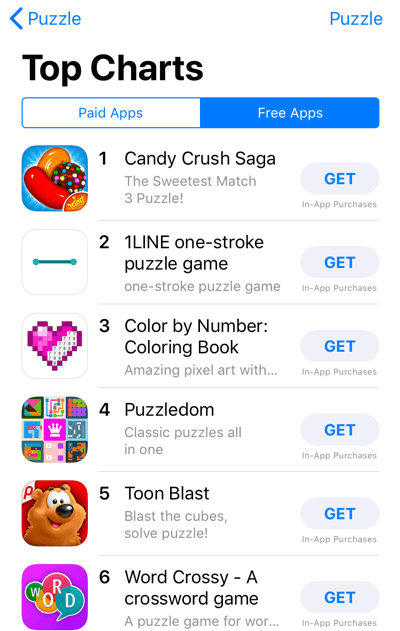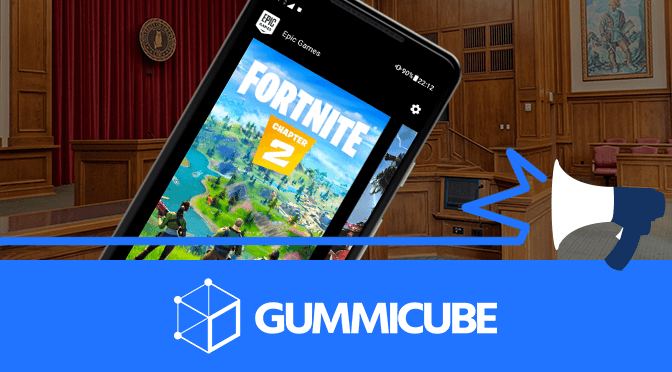Genre Showcase: Puzzle Games
March 14th, 2018


by David Quinn
VP of Strategy & Partnerships at Gummicube, Inc.
When you're bored and looking for a way to kill time while improving your quick-thinking skills, what do you do? Do you pull out a crossword and start testing your vocabulary? Do you grab a deck of cards and enjoy what could be a frustrating game of solitaire? Now that we have handy mobile devices at our disposal, we're quick to forget about these physical objects and go for their digital counterparts. These are often found in the form of mobile puzzle games. Since the puzzle game genre can span across categories such as casual, board games and puzzle itself, we should first give puzzle games a definition for the purpose of this article. These games are oftentimes a test that assesses an individual's problem-solving skills, ingenuity and knowledge to arrive at the correct solution. But since there are so many games that can fall under the puzzle umbrella, how do competitors in the current ecosystem stand apart? This is where creatives come in - they play a key role in helping users easily recognize the app while understanding its core feature and functionality. By looking at how top puzzle games are creating icons, screenshots and even preview videos, we'll surely find some commonalities that can be used by others looking for a shot at the spotlight.
Common Themes Among Icons for Puzzle Games
If we take a look at the Top Charts in the App Store, we'll notice many commonalities among various puzzle games and their color choices. Four out of the top six apps under the 'puzzle' category in the App Store use bright colors that immediately grab a user's attention.

Colors that are primarily used for puzzle games are:
Pink
Light blue
Bright red
Green
Orange
Along with these colors, the icons themselves incorporate supplementary treatments such as drop shadows or starbursts to make one particular element of the icon stand out. The icons themselves feature either puzzle boards or pieces and characters from the game to help users easily identify it. Take Candy Crush Saga - a casual puzzle game that has been out since 2012 - for example. Most would say that they don't even need to know the game's name because it is instantly recognizable by its bright colors and distinguishable in-game puzzle pieces. This is why when users are browsing through the app stores, many will typically know that this icon belongs to Candy Crush Saga.

Screenshots That Capture Attention
Screenshots are key for developers to highlight their app's core features. Since there are many competitors, and often times these competitors have very similar apps, their screenshots tend to be nearly identical. If we look at two games that are under the "board" category for the App Store, Pixel Art and UNICORN 3D, we'll notice that both take a very different approach to screenshots while still having similarities.

Each screenshot illustrates 3D elements in pixel-style artwork from in-app gameplay.
While both have a different color scheme, they want users to know that the game itself is a colorful way to bring art to life.
Both focus on their core feature, which is coloring. Pixel Art actually takes their first screenshot a step further and shows a user interacting with the game.
Each screenshot has short and concise callout text that integrates high-volume keywords to highlight the game's core feature. UNICORN 3D's callout text is a bit longer and uses punctuation, but it still effectively conveys the message.
It could be said that these games' screenshots follow effective trends and apply basic ASO best practices when creating their screenshots. Regardless, their screenshots are surely contributing factors to each game's success and are a key reason why each has managed to convert users.
Simple Yet Engaging Preview Videos
While screenshots can often get the job done and translate the game's core features, sometimes users want to see the game in action. That's when they turn to a preview video (if available) to see what the game is like. Preview videos are exceedingly valuable because not only do they show the game in action, but they also give users a glimpse into the app's interface and functionality. This can be the breaking point for some puzzle games because if users don't easily understand the game's mechanics, they might turn around and install a competitor's app. If we look at
Cookie Jam and Kuros Classic, both of these games highlight their app's mechanics within just the first few seconds of the preview video. Similar to screenshots, each app takes a slightly different approach, but the two are inherently the same.

Both have callout text to explicitly say what the game is. Each one's callouts are lengthy enough to explain either the game's core feature or address the gameplay.
Per Apple's guidelines, both feature in-app content. Each preview video features fun in-app animation to show what happens when users complete a puzzle or match pieces.
Both incorporate a color scheme that is on-brand and attractive to users. As we noticed in the icons, many puzzle games tend to leverage the same colors. Each of the above apps incorporate these colors in a variety of applications that highlight their app's functionality while staying on-brand.
Each preview video is uncluttered and clearly expresses the app's core feature. There's no guessing what type of games these are, which helps users easily decide on whether they want to install or not.
Key Takeaways
Despite the number of games that can fall under the puzzle genre, there are many commonalities among their creatives. Nearly all puzzle games feature:
Bright, bold colors that engage with users
A recognizable object, character or element
Callout texts in screenshots and preview videos
It's because of these characteristics that puzzle games are able to attract users and capture their attention. Many of these games follow what could be considered as "standard" practices in the mobile puzzle game space, however, each implements these practices in their own unique way to stand out and capture a user's attention.
Similar Articles

Posted on August 15th, 2020
Every time a user makes an in-app purchase or buys an app from the App Store or Play Store, Apple or Google takes a portion of the revenue. This App Store Tax has caused complaints for some developers, but with Apple and Google in the middle of antitrust hearings, tensions are continuing to grow.

Posted on August 8th, 2020
Apple has a strict set of App Store Guidelines that developers must follow in order to avoid being removed. Recently, it was announced that the guidelines will prevent developers from selling cloud gaming apps on the App Store. This could have an impact on app marketing, development and App Store Optimization.

Posted on July 7th, 2020
Apple Arcade, the App Store’s subscription game service, provides users with unlimited access to over 100 games for the price of $4.99 a month. Yet Apple can afford to be choosy, as it's cancelling several Arcade game contracts in the company’s effort to maintain subscribers.









